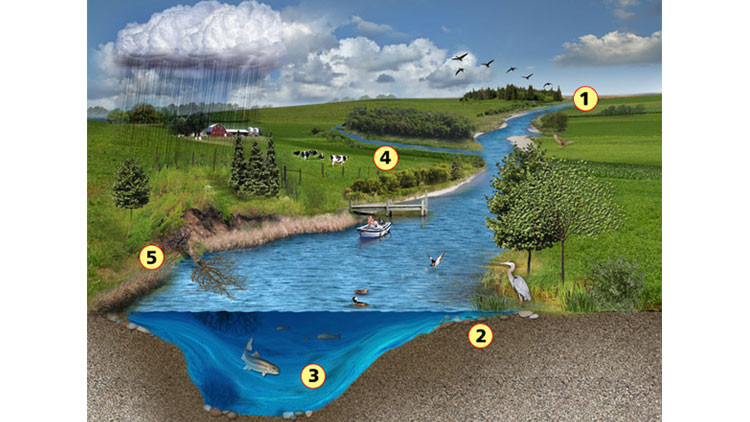Government mail service may be affected by the Canada Post labour disruption. Learn about how critical government mail will be handled.
What environmental flows are
Aquatic ecosystems such as rivers, streams and lakes, need certain levels of water flow throughout the year to remain healthy and sustainable. Environmental flows, also known as instream flows or instream flow needs, are a measure of that water quantity and quality over time. Monitoring and planning for environmental flows conserve freshwater ecosystems, and protect the life that depends on them.
When studying environmental flows, 5 elements of an aquatic ecosystem’s ecology (river or lake) need to be addressed:
- Hydrology: The water in the river. Environmental flows protect all components of the natural flow regime needed to sustain river ecosystems.
- Biology: The life in the river. As flows diminish, suitable habitat for vulnerable life-stages of fish and other life may become threatened.
- Water quality: The health of the water. Adequate flows help maintain river temperatures and dissolved oxygen levels necessary for aquatic life.
- Connectivity: Watershed connections and health. Healthy rivers naturally connect to their floodplains, which need to be maintained through good land use practices.
- Geomorphology: River banks and channels. High flows carve into river beds, continually rejuvenating the required habitat for fish and wildlife.
Image 1. Five elements of a river or stream’s ecology

Natural flow regimes
Natural flow regimes include flow magnitude, frequency, duration, timing and rate of change. Maintaining a natural flow regime is fundamental to meeting the requirements of the 5 ecosystem components, and is important to consider when planning for water withdrawals or other flow alteration. The natural variability of the flow is critical as a healthy aquatic ecosystem cannot be maintained with a single flow value.
Benefits of a natural flow regime
- All elements of the natural flow regime play a critical role in sustaining native biodiversity and overall ecosystem integrity.
- All rivers and lakes have variable high and low flow and water levels and this variability is critical as it periodically restores different physical, chemical and biological functions essential to the ecosystem.
- The aquatic biota have adapted to the variability of flow required for their life cycles. The completion of a life cycle requires an array of different habitat types, whose availability over time is regulated by the flow regime.
- Flow in a river is naturally variable, with changes in flow within a year and changes in flow from one year to the next. In any given river, some species do well in high flow years and other species do well in low flow years. Therefore, a single flow value (minimum, optimal or otherwise) cannot meet the requirements for all species or maintain a fishery.
Altering the natural flow regime
- People use or manage river flows and lake levels for a number of reasons, including:
- flood protection
- industrial processing
- irrigation for agriculture
- power generation
- water supply for drinking
- Removing water from a river or lake affects all five elements of aquatic ecology (see Image 1 above). For example, water withdrawals can affect the water chemistry, such as temperature and dissolved oxygen. Fish have specific tolerances for temperature and dissolved oxygen is what they need to breathe. A change in temperature or dissolved oxygen can have important consequences for fish and other aquatic organisms.
- Sufficient water flow at the right time of year provides fish with enough water to move up and downstream for spawning. Changes in flow volumes and timing may also impact temperature cues critical for triggering spawning.
- If environmental flows are not maintained, the river can become slower, narrower and shallower. This can change the river's suitability as fish habitat, meaning that as the environmental flows change, the species of fish that can thrive there will change.
- Dams and other structures can remove natural variability in river flows. For example, a structure may reduce high water flows which are necessary to move the sediment which maintains the viable habitat within river channels.
- Taking too much water out of a river or lake, or altering the flow or water level too much, causes stress to fish and other organisms. The Environmental Flows Program works at understanding what is 'too much' and collaborates with others to protect these flows.